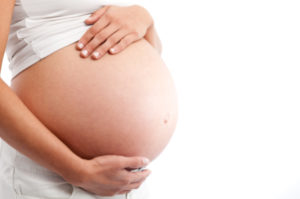 Healthy women were followed during their pregnancies and postpartum, and it was found that vaginal microbial communities change over the course of pregnancy, and then really change postpartum. They also found differences in the predominant Lactobacillus bacteria species between the women. In this study it was found that Lactobacillus bacteria were most dominant during pregnancy, especially L. gaserii, L. crispatus, L. iners, and L. jensenii, and there were ethnic differences in the species. And they found that the vaginal microbiome changes postpartum, with bacteria becoming more diverse and the numbers of Lactobacillus dropping. The message here is that what are "normal and healthy" microbial communities can vary between women (in this study which Lactobacillus species were "healthy and normal" varied among women). Remember: dysbiosis means that the normal microbial community is "out of whack". And sequenced the microbiomes means state of the art genetic analysis of the microbial communities From American Microbiome Institute:
Healthy women were followed during their pregnancies and postpartum, and it was found that vaginal microbial communities change over the course of pregnancy, and then really change postpartum. They also found differences in the predominant Lactobacillus bacteria species between the women. In this study it was found that Lactobacillus bacteria were most dominant during pregnancy, especially L. gaserii, L. crispatus, L. iners, and L. jensenii, and there were ethnic differences in the species. And they found that the vaginal microbiome changes postpartum, with bacteria becoming more diverse and the numbers of Lactobacillus dropping. The message here is that what are "normal and healthy" microbial communities can vary between women (in this study which Lactobacillus species were "healthy and normal" varied among women). Remember: dysbiosis means that the normal microbial community is "out of whack". And sequenced the microbiomes means state of the art genetic analysis of the microbial communities From American Microbiome Institute:
The vaginal microbiome changes during and after pregnancy
The vaginal microbiome is critically important to a healthy pregnancy, and studies have shown that vaginal dysbiosis during pregnancy can lead to infection and preterm birth. In order to help understand what the microbiome looks like throughout and just after pregnancy, researchers from England performed longitudinal studies on 42 pregnant women. They published their results last week in Nature Scientific Reports.
The scientists sequenced the microbiomes of the 42 women throughout their pregnancies, and then for the 6 weeks afterwards for some of the women. They discovered, in agreement with other literature on the subject, that the vaginal microbiome becomes dominated by Lactobacilli species during pregnancy. The Lactobacilli are thought to prevent pathogens from colonizing the vagina because they produce lactic acid which decreases the overall pH of the vagina, and they secrete antibacterial toxins. These Lactobacilli are also important as they are normally the first to colonize the new infants' guts after they pass through the birth canal.
The researchers also learned that the microbiome shifts away from Lactobacilli and towards a more diverse microbiome in the period immediately following birth. The new bacteria that colonize are often associated with vaginosis, and these can lead to inflammation and infection of the birth canal in some women. The scientists suspect this shift occurs because there is a sudden drop in estrogen production upon removal of the placenta. The increase in circulating estrogen is thought to be important for Lactobacilli colonization, so it makes sense that the rapid decrease in estrogen decreases Lactobacilli abundance.
Finally, this study showed that there were geographic and ethnic variations to the pregnant microbiome. While each microbiome was associated with a healthy pregnancy, there were important differences, especially on the species level. For example, Asian and Caucasian women’s pregnant microbiomes were dominated by Lactobacillus gasseri, while this species was absent in black women’s pregnant microbiomes.
